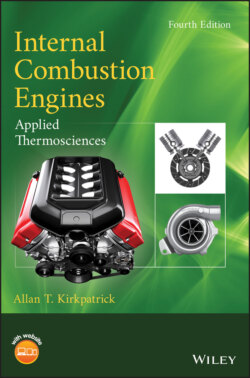Читать книгу Internal Combustion Engines - Allan T. Kirkpatrick - Страница 16
Compression Ignition Engine
ОглавлениеThe four‐stroke compression ignition engine has the following sequence:
1 An intake stroke draws inlet air past the intake valve into the cylinder.
2 A compression stroke raises the air temperature above the autoignition temperature of the fuel. Diesel fuel is sprayed into the cylinder near the end of the compression stroke.
3 Evaporation, mixing, ignition, and combustion of the diesel fuel occur during the later stages of the compression stroke and the expansion stroke.
4 An exhaust stroke pushes out the burned gases past the exhaust valve.
The inlet air in the diesel engine is unthrottled, and the combustion is lean. The power is controlled by the amount of fuel injected and the subsequent mixing of the fuel spray with the inlet air. The injection duration is proportional to the engine load. In order to ignite the fuel–air mixture, diesel engines are required to operate at a higher compression ratio, compared to spark‐ignition (SI) engines, with typical values in the range of 15 to 20, resulting in a greater theoretical efficiency. Since the diesel fuel is mixed with cylinder air just before combustion is to commence, the knock limitation that occurs in SI engines is greatly reduced.
Diesel engine performance is limited by the time required to mix the fuel and air, as incomplete mixing and combustion results in decreased power, increased unburned hydrocarbon emissions, and visible smoke. As we shall see, many different diesel combustion chamber designs have been invented to achieve adequate mixing. There are two main types of diesel combustion systems, direct injection (DI) into the main cylinder and indirect injection (IDI) into a prechamber connected to the main cylinder. Direct injection engines predominate when the operating range of the engine is fairly narrow, such as in ships, locomotives, and electric power generation. Indirect injection engines tend to be used where the engine is expected to perform at high speeds over a wide range of loads, such as in an automobile.
With indirect injection, air is compressed into a prechamber during the compression stroke, producing a highly turbulent flow field, and thus high mixing rates when the diesel fuel is sprayed into the prechamber toward the end of the compression stroke. The combustion process is initiated in the prechamber, raising the pressure in the prechamber above that of the main chamber, which forces the combusting mixture of burning gases, fuel, and air back into the main chamber, resulting in the propagation of a highly turbulent swirling flame into the main chamber.
Since the mixing time is inversely proportional to the engine speed, diesel engines are classified into three classes, high speed, medium speed, and low speed. High‐speed diesels are designed to operate at speeds of 1000 rpm or higher, have up to a 300 mm bore, and use high quality distillate fuels. Medium‐speed diesels operate at speeds of 375–1000 rpm, have a medium bore typically between 200 and 600 mm, and can operate with a range of fuels. The low‐speed class of diesel engines operate at speeds less than 375 rpm, are typically large bore ( 600 mm) two‐stroke cycle engines, and use residual fuel oil. Each engine manufacturer has worked to optimize the design for a particular application, and that each manufacturer has produced an engine with unique characteristics illustrates that the optimum design is highly dependent on the specific application.
